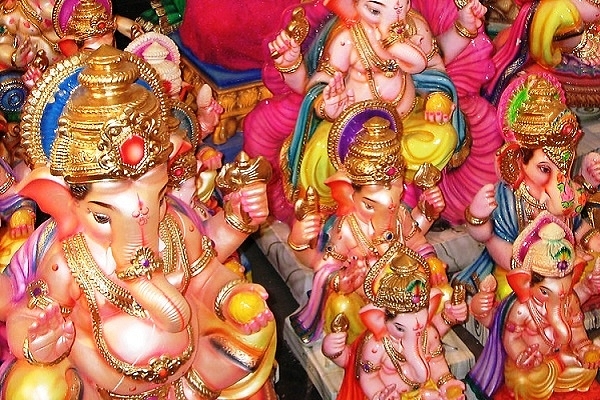News Brief
Share Of Chinese Goods In Delhi’s Diwali Idol Market Falls From 80 To 10 Per Cent, Here’s How India Fought Back

Idols of Lord Ganesha - representative image (abcdz2000/Flickr)
The share of Chinese products in the Delhi’s Diwali idol market, which until five-six years ago dominated it with 70 to 80 per cent market share, is now down to 10 per cent this time round, Press Trust of India has reported.
This figure has been claimed by a traders’ organisation Delhi Vyapar Mahasangh operating in the national capital.
The Indian idols which are now dominating the market are mainly being manufactured in Burari, Pankha Road, Ghazipur, Old Delhi and Meerut.
What Caused This Turnaround
As per the president of the traders body Devraj Baweja, shopkeepers this year decided to import a lower number of made in China idols and replaced them with the ones Made In India.
This decision was motivated by various factors including demonstrations against the use of Chinese goods last year.
These idols are said to be of gods and goddesses like Ganesha, Lakshmi, Shiva, Durga and Saraswati.
Indian idol makers also deserve credit for tilting the market share in favour of Made-In-India goods. As per Baweja, they have now learned the technique used by China to make the Hindu idols and have incorporated it in their making process.
The pricing of Indian made idols is lower than their Chinese counterparts by a magnitude of almost 30 to 40 per cent. To top it off, the Made In India idols are more durable and lasting.
Another big aspect of this development which cannot be overlooked is the desire for Diwali shoppers to buy Indian products and consciously avoid Chinese ones.
Campaign To Promote Indian Diyas Over Chinese Light
Chinese idols aren’t the only ones threatening the traditional Indian artisan and electronic Chinese lights have turned out to be a big threat for traditional diya makers.
As reported recently, in light of the Chinese products affecting the livelihood of these humble artisans, social media activists and common citizens started a campaign to promote Indian potters and their products.
This included an appeal to patronise the diya makers by buying their products without bargaining so that they can sustain their traditional livelihood.
The response has also percolated to the ground, with various parts of the country reporting a big demand for the earthen diyas, a turnaround from the situation prevalent few years ago.
Movement To Boycott Chinese Goods
In recent times, a desire to reduce dependency on Chinese goods and in turn hurt its economy, can be traced back to 2016 following the dastardly Uri terror attack.
A sizeable number of the Indian population was up in arms over the tacit support of China to Pakistan, with the latter promoting terrorism in the country.
This was fuelled by various online and offline campaigns to boycott goods manufactured by “Pakistan’s friend”. The boycott calls coincided with the Navratra and Diwali festive season.
The result? Sales of Chinese products like decorative lights crashed by almost 40 per cent and China made electronics sales to fell by 10 to 15 per cent.
Support Swarajya's 50 Ground Reports Project & Sponsor A Story
Every general election Swarajya does a 50 ground reports project.
Aimed only at serious readers and those who appreciate the nuances of political undercurrents, the project provides a sense of India's electoral landscape. As you know, these reports are produced after considerable investment of travel, time and effort on the ground.
This time too we've kicked off the project in style and have covered over 30 constituencies already. If you're someone who appreciates such work and have enjoyed our coverage please consider sponsoring a ground report for just Rs 2999 to Rs 19,999 - it goes a long way in helping us produce more quality reportage.
You can also back this project by becoming a subscriber for as little as Rs 999 - so do click on this links and choose a plan that suits you and back us.
Click below to contribute.
Latest